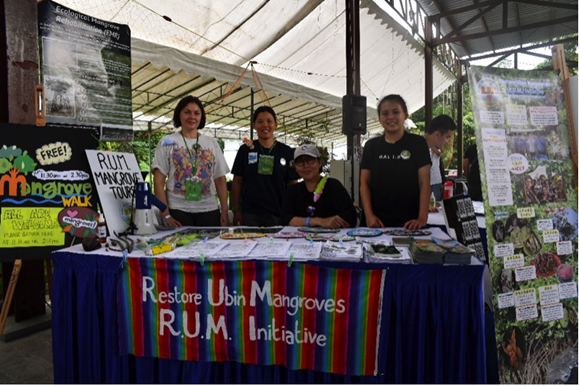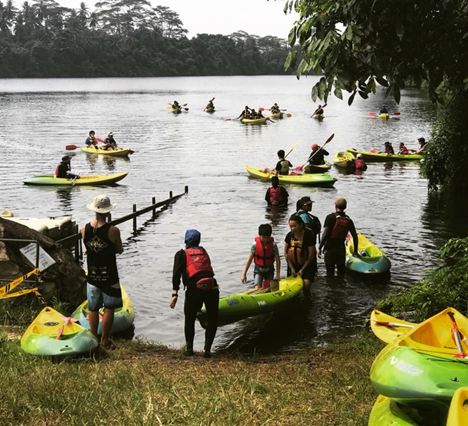Community, Heritage and History
The Ubin Project encourages members of the community to actively organise and lead initiatives that help to make a difference on the island. Key community efforts include the annual open house festival Pesta Ubin, Balik Kampong Party, and the restoration of kampong structures. One refurbished traditional house is Teck Seng's Place, an authentic Chinese kampong house that is open for the public to learn about Pulau Ubin's cultural heritage. Many photographs and display items in it were contributed by the local Ubin community.
Ubin Day
First started in 2002, Ubin Day is a yearly community event held at Pulau Ubin to celebrate the different facets of the island. During Ubin Day, various community groups set up educational booths and organise a myriad of activities in collaboration with NParks on the island.

Restore Ubin Mangroves (R.U.M) Initiative booth at Ubin Day
Pesta Ubin
Pesta Ubin started as a festival organised by FUN members and the community as an extended celebration of Ubin Day in 2016. It aims to highlight the island’s culture, heritage and biodiversity through the various activities held throughout the period. In collaboration with NParks, volunteers and community groups organised activities such as kayaking, kampong, nature tours, and art workshops during Pesta Ubin.

A Pesta Ubin kayaking event at Ubin Quarry organised by Republic Polytechnic
Kawan Ubin
Kawan Ubin is a project spearheaded by the Singapore Heritage Society (SHS) that aims to help conserve Ubin’s heritage. On 24 February 2018, NParks and Kawan Ubin worked together to throw the first Balik Kampung party for the residents, past and present and their families. The celebration aimed to be the first in a series of community get-togethers and included games, dinner, a documentary screening and even a “lohei” session.

Former and current mingling at the Balik Kampung Party
Tudor House in Pulau Ubin
This one-of-a-kind house may well be the only authentic Tudor-style building with a fireplace in Singapore. Fondly known as House No. 1 (its postal address on Pulau Ubin), the cottage was built in the 1930s by the then Chief Surveyor, Langdon Williams, as a holiday retreat. Its unique architecture style is similar to that of tea plantation residences during the British colonial era.
The building was designated a Conservation Building by the Urban Redevelopment Authority (URA) in December 2003, and works began to restore it after decades of exposure to the harsh coastal conditions. Much effort went into retaining the building’s original design – replacement materials were carefully sourced while layers of dirt and grime were painstakingly removed from the stone and brickwork to expose the original finish.
In 2007, as part of the newly launched Chek Jawa Wetlands, House No. 1 was opened to the public as the Chek Jawa Visitor Centre. In the same year, it received an Architectural Heritage Award from URA.
Pulau Ubin Cultural Mapping Project
The National Heritage Board (NHB) commissioned a Cultural Mapping Project to study the island’s community and social networks in April 2015. The year-long project documented the well-loved island’s living heritage through oral history accounts and lifestyles of its current and former residents.
The findings revealed that Pulau Ubin’s kampong-centred social network is a thriving one, and even extends beyond residents of the island to non-residents and regular visitors.
The kampong lifestyle endures on Pulau Ubin with unique cultural events like the week-long Tua Pek Kong festival, which continues to strengthen local bonds of friendship. The festival, which features spirit medium processions, rituals, opera, getai (live stage) performances and lion dances, also attracts thousands of visitors to the island. This offers a platform to renew and expand the social network that spans from the island to the mainland.
Visitors to Pulau Ubin are drawn into the network through diverse connections with the island, whether through work, family-run businesses, informal apprenticeships, religious activities, or fitness and leisure. The constant flow of non-residents to the island and their induction into the existing network reflect an evolving kampong community.
As part of the project, NHB has produced a 25-minute documentary titled Life on Ubin, which presents the memories and experiences of current and former residents of the island. Click here to watch the video.
“I have lived on Ubin for around twenty years. I have spent most of my life in the hills or out at sea. I have been running around on beaches since I was five. I learnt the hook technique from observing others. Some people may know how to use the hook to extract crabs but very few know how to do so without injuring the crabs … I can sell 200-gram crabs, but I can’t bring myself to do so. They should not be caught when they are not fully grown.”
– Quek Kim Kiang
Crab catcher
“In our village on this island, life is quiet and peaceful. When we sleep at night, it feels healthy, quiet and cool … In the past, we villagers practised gotong royong (community spirit). We worked together and neighbours came together to help each other. That’s how life was.”
– Ahmad bin Kassim
Drink stall owner at Malay village

